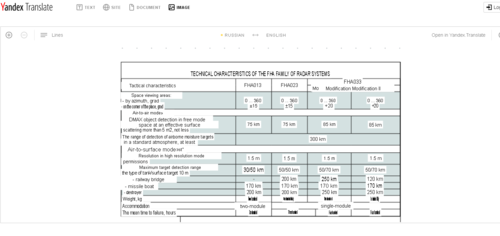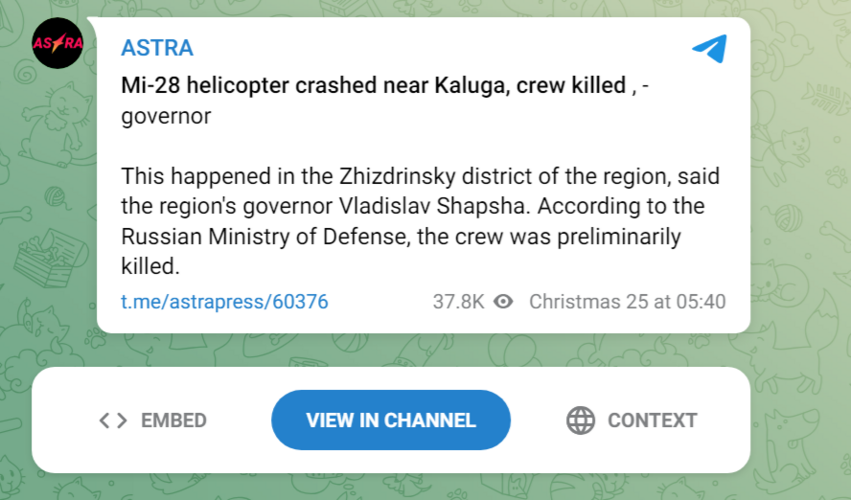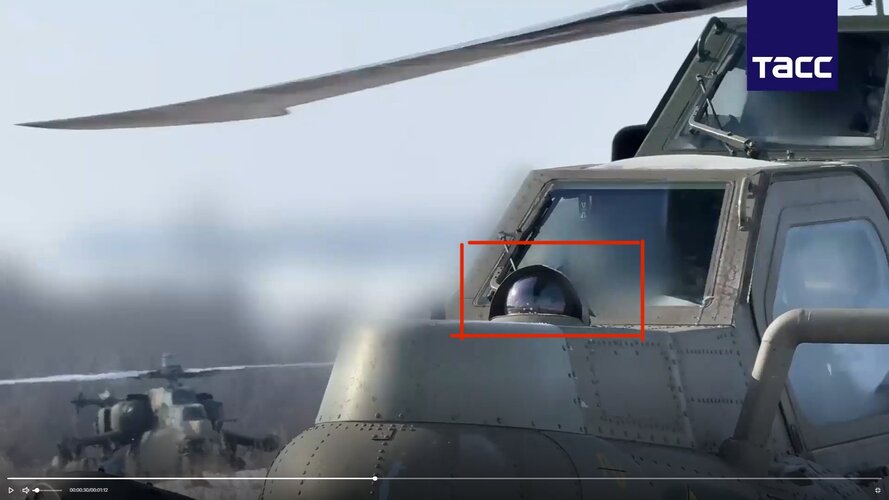- Joined
- 1 April 2006
- Messages
- 11,386
- Reaction score
- 10,267
http://en.rian.ru/russia/20080122/97491904.html
Russian Air Force receives new Mi-28N attack helicopters
11:41 | 22/ 01/ 2008
MOSCOW, January 22 (RIA Novosti) - Two new Mi-28N Night Hunter helicopter gunships will be transferred to the Russian Air Force on Tuesday by the manufacturer, an AF spokesman said.
The Mi-28N is the latest variant of the Mi-28 attack helicopter, manufactured by the Rostvertol plant in southern Russia. It has been designed to conduct hunter-killer missions against enemy main battle tanks, helicopters, ground forces and armored equipment day or night in adverse weather conditions.
"Air Force Commander Col. Gen. Alexander Zelin flew this morning to Rostov-on-Don to attend the official transfer of two Mi-28N helicopters to an air unit in the Tver Region [Central Russia]," Col. Alexander Drobyshevsky said.
The Night Hunter is powered by two TV3-117VMA turbo-shaft engines developing 2,200-shp each. The armored cockpit protects the crew from small arms fire and absorbs the impact energy during emergency landings, ensuring outstanding survivability.
Its combat range with internal fuel tanks is 450 kilometers (about 280 miles), but with external fuel tanks may be extended to 1,100 km (about 680 miles).
Rosvertol launched mass production of the Mi-28N helicopters last year.
Russia's Defense Ministry is planning to purchase 67 Mi-28N Night Hunter attack helicopters in the next few years and to fully replace the Mi-24 Hind choppers in the armed forces by 2015.
http://en.rian.ru/russia/20080122/97530653.html
Russian military to purchase 10-15 Mi-28N helicopters per year
16:33 | 22/ 01/ 2008
ROSTOV-ON-DON, January 22 (RIA Novosti) - Russia's Defense Ministry is planning to purchase at least 10-15 Mi-28N Night Hunter attack helicopters every year until 2015, a ministry official said on Tuesday.
The Mi-28N is the latest variant of the Mi-28 attack helicopter, manufactured by the Rostvertol plant in southern Russia. It has been designed to conduct hunter-killer missions against enemy main battle tanks, helicopters, ground forces and armored equipment day or night in adverse weather conditions.
"The [Mi-28N] procurement program will last until 2015. In the next few years, we are planning to purchase 10-15 helicopters per year, and later increase annual orders," said Gen. Nikolai Makarov, chief of Armament for the Russian Armed Forces.
Russia's Defense Ministry is planning to purchase at least 45-50 Mi-28N Night Hunter attack helicopters until 2010, and to fully replace the Mi-24 Hind choppers in the armed forces by 2015.
Rosvertol launched mass production of the Mi-28N helicopters last year.
On Tuesday, the first two mass-produced Mi-28N were transferred to the Russian Air Force by the manufacturer. They will be deployed at a training center in the Tver Region (Central Russia) [Torzhok] .
The Night Hunter is powered by two TV3-117VMA turbo-shaft engines developing 2,200-shp each. The armored cockpit protects the crew from small arms fire and absorbs the impact energy during emergency landings, ensuring outstanding survivability.
Its combat range with internal fuel tanks is 450 kilometers (about 280 miles), but with external fuel tanks may be extended to 1,100 km (about 680 miles).
Meanwhile, Rosvertol general director, Boris Slyusar, said his company was ready to start deliveries of Mi-28N helicopters to Venezuela as early as in the second half of 2009, if the Latin American country signs a contract with Russia.
"We have an official request from Venezuela, but it is too early to talk about the number of aircraft to be delivered and the timeframe until a contract is signed," Slyusar said. "Other than that, we are ready to start deliveries in the second half of 2009."
Russia may also sell the Night Hunter to China, Algeria and some other countries.
Event videos
http://skavkaz.rfn.ru/video.html?id=30899&type=r
http://www.vesti.ru/videos?vid=119468&cid=39&doc_type=news&doc_id=158336
http://news.ntv.ru/124896/
Russian Air Force receives new Mi-28N attack helicopters
11:41 | 22/ 01/ 2008
MOSCOW, January 22 (RIA Novosti) - Two new Mi-28N Night Hunter helicopter gunships will be transferred to the Russian Air Force on Tuesday by the manufacturer, an AF spokesman said.
The Mi-28N is the latest variant of the Mi-28 attack helicopter, manufactured by the Rostvertol plant in southern Russia. It has been designed to conduct hunter-killer missions against enemy main battle tanks, helicopters, ground forces and armored equipment day or night in adverse weather conditions.
"Air Force Commander Col. Gen. Alexander Zelin flew this morning to Rostov-on-Don to attend the official transfer of two Mi-28N helicopters to an air unit in the Tver Region [Central Russia]," Col. Alexander Drobyshevsky said.
The Night Hunter is powered by two TV3-117VMA turbo-shaft engines developing 2,200-shp each. The armored cockpit protects the crew from small arms fire and absorbs the impact energy during emergency landings, ensuring outstanding survivability.
Its combat range with internal fuel tanks is 450 kilometers (about 280 miles), but with external fuel tanks may be extended to 1,100 km (about 680 miles).
Rosvertol launched mass production of the Mi-28N helicopters last year.
Russia's Defense Ministry is planning to purchase 67 Mi-28N Night Hunter attack helicopters in the next few years and to fully replace the Mi-24 Hind choppers in the armed forces by 2015.
http://en.rian.ru/russia/20080122/97530653.html
Russian military to purchase 10-15 Mi-28N helicopters per year
16:33 | 22/ 01/ 2008
ROSTOV-ON-DON, January 22 (RIA Novosti) - Russia's Defense Ministry is planning to purchase at least 10-15 Mi-28N Night Hunter attack helicopters every year until 2015, a ministry official said on Tuesday.
The Mi-28N is the latest variant of the Mi-28 attack helicopter, manufactured by the Rostvertol plant in southern Russia. It has been designed to conduct hunter-killer missions against enemy main battle tanks, helicopters, ground forces and armored equipment day or night in adverse weather conditions.
"The [Mi-28N] procurement program will last until 2015. In the next few years, we are planning to purchase 10-15 helicopters per year, and later increase annual orders," said Gen. Nikolai Makarov, chief of Armament for the Russian Armed Forces.
Russia's Defense Ministry is planning to purchase at least 45-50 Mi-28N Night Hunter attack helicopters until 2010, and to fully replace the Mi-24 Hind choppers in the armed forces by 2015.
Rosvertol launched mass production of the Mi-28N helicopters last year.
On Tuesday, the first two mass-produced Mi-28N were transferred to the Russian Air Force by the manufacturer. They will be deployed at a training center in the Tver Region (Central Russia) [Torzhok] .
The Night Hunter is powered by two TV3-117VMA turbo-shaft engines developing 2,200-shp each. The armored cockpit protects the crew from small arms fire and absorbs the impact energy during emergency landings, ensuring outstanding survivability.
Its combat range with internal fuel tanks is 450 kilometers (about 280 miles), but with external fuel tanks may be extended to 1,100 km (about 680 miles).
Meanwhile, Rosvertol general director, Boris Slyusar, said his company was ready to start deliveries of Mi-28N helicopters to Venezuela as early as in the second half of 2009, if the Latin American country signs a contract with Russia.
"We have an official request from Venezuela, but it is too early to talk about the number of aircraft to be delivered and the timeframe until a contract is signed," Slyusar said. "Other than that, we are ready to start deliveries in the second half of 2009."
Russia may also sell the Night Hunter to China, Algeria and some other countries.
Event videos
http://skavkaz.rfn.ru/video.html?id=30899&type=r
http://www.vesti.ru/videos?vid=119468&cid=39&doc_type=news&doc_id=158336
http://news.ntv.ru/124896/























